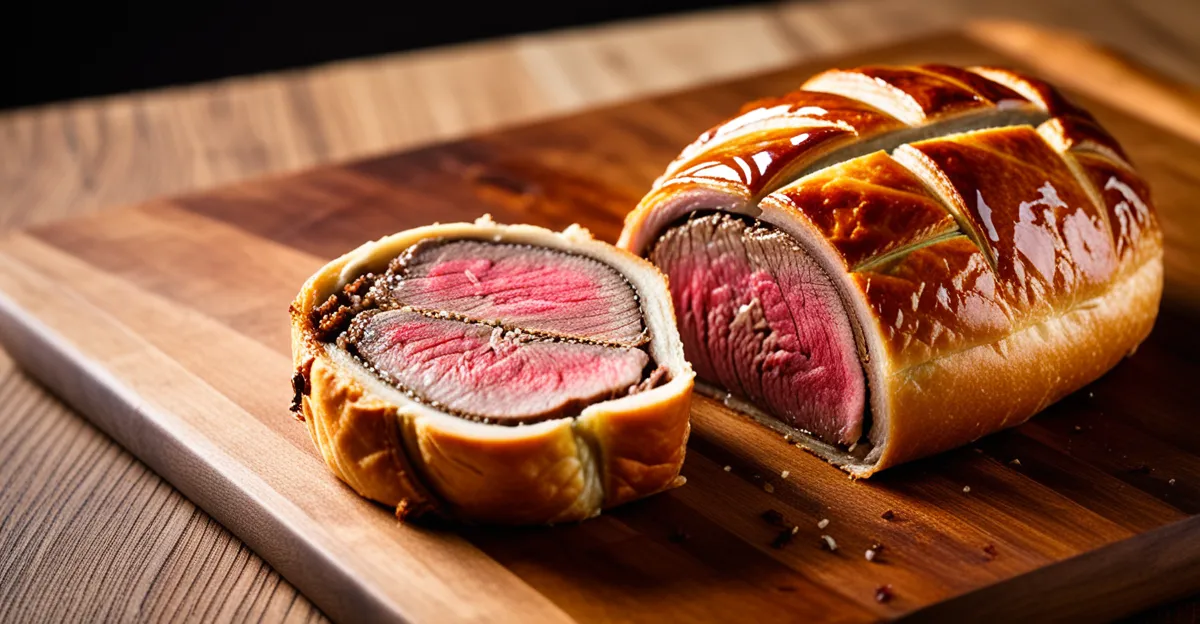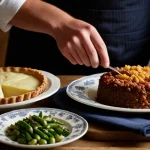Understanding Beef Wellington
Beef Wellington is a celebrated dish that holds a prominent place in culinary traditions. It typically consists of a succulent fillet steak coated with pâté, often made from ingredients like foie gras or duxelles, a flavorful mushroom mixture. The entire preparation is then enrobed in a golden, flaky puff pastry, creating an indulgent dining experience that is both rich and complex.
The history of Beef Wellington is intriguing, although somewhat unclear. It is often associated with the 1st Duke of Wellington, Arthur Wellesley, who defeated Napoleon at the Battle of Waterloo. However, the exact origin remains a matter of debate. Some culinary historians suggest it might be an adaptation of the French dish “filet de boeuf en croûte.” Despite the murky origins, what remains evident is Beef Wellington‘s significance as a symbol of opulence and mastery in Western gastronomy.
Also to discover : How Can Traditional British Recipes Be Modernized?
Preparing the Beef
Choosing the right cut of beef is crucial for a successful Beef Wellington. The preferred cut is a tenderloin, prized for its tenderness and mild flavor, allowing other elements like the pâté and puff pastry to shine. Look for a piece with an even thickness to ensure uniform cooking.
Once selected, the beef must be seasoned well. A simple blend of salt and freshly ground pepper can make a substantial difference, enhancing the meat’s natural flavors. For those seeking a deeper flavor profile, consider marinating the beef. Opt for a short marinade with ingredients like garlic, herbs, and a touch of olive oil. Marinating not only infuses the beef with additional flavors but also helps to tenderize it further.
Also read : What are the top tips for creating a hearty English breakfast?
Searing the beef is an essential step that should not be overlooked. This process caramelizes the meat’s surface, creating a rich, deep flavor and a beautiful crust that seals in juices. Heat a pan until it’s very hot, add a high smoke point oil like vegetable oil, and sear the beef on all sides until it develops a golden-brown crust. This step is not just about flavor enhancement but also crucial for the structural integrity of the dish when wrapped in pastry. Proper preparation of the beef sets the stage for a truly exceptional Beef Wellington.
The Mushroom Duxelles
Mushroom duxelles play a pivotal role in the preparation of Beef Wellington, providing a savory and aromatic layer that complements the tender beef and crisp pastry. Preparing this component requires close attention to both ingredients and technique to maximize its impact on the final dish.
Ingredients and Preparation
Typically, a classic duxelles consists of finely chopped mushrooms, shallots, and herbs such as thyme. Begin by cleaning and chopping these ingredients to a uniformly fine consistency, ensuring they will integrate seamlessly during assembly. The choice of mushrooms—such as cremini or porcini—offers distinct flavors that can be adjusted based on preference.
Cooking Techniques for Flavor Enhancement
To enhance the flavor of the mushroom mixture, cook the duxelles over medium heat until any moisture released from the mushrooms has evaporated. The process of sautéing helps to concentrate flavors, resulting in a robust, umami-rich filling. A knob of butter and a splash of white wine, reduced until dry, adds a luxurious depth.
Importance of Moisture Control
Controlling moisture is crucial to maintaining the structural integrity of the Beef Wellington. Excess moisture in the duxelles can compromise the pastry, leading to a soggy texture. Therefore, it is vital to cook the mixture until it’s sufficiently dry, allowing the puff pastry to remain crisp and flaky when the Wellington is baked.
By mastering the preparation of mushroom duxelles, you elevate the taste and texture profiles essential for a classic Beef Wellington experience.
Assembling the Wellington
Assembling a Beef Wellington is a blend of art and procedure, where careful attention to detail ensures the harmony of flavors and textures. The standout component in this process is the puff pastry, which cradles the beef and additional layers, each step meticulously planned to accentuate the dish’s sophisticated complexity.
Step-by-Step Guide
Begin by rolling out the puff pastry, keeping it thin but durable. Ensure the beef, duxelles, and, if used, pâté are adequately cooled; this prevents the pastry from becoming soggy during assembly. Lay the duxelles over the pastry, followed by wrapping the seared beef snugly, ensuring the duxelles create an even layer.
Importance of Layering
Layering the ingredients correctly is vital for maintaining the balance of flavors. The beef should be fully encased in the mushroom duxelles and any pâté, with the edges of the pastry skillfully pulled together and sealed, safeguarding the juiciness within. This careful layering ensures that each bite delivers the desired depth and richness.
Ensuring Pastry Quality
For the pastry to adhere well and remain crispy, apply a light egg wash to the edges. This not only acts as glue but also encourages a tantalizing golden hue upon baking. Take care to vent the pastry by cutting small slits on top, allowing steam to escape and maintaining the puff pastry’s integrity. Through these techniques, you can produce a perfectly assembled Beef Wellington, ready for the culinary spotlight.
Cooking Techniques
Cooking a Beef Wellington to perfection requires understanding the delicate balance of methods, temperatures, and timing. The preferred cooking method is to bake the Wellington in a preheated oven. Ensuring the right oven temperature is crucial; typically, a temperature of 200°C (about 390°F) provides the ideal environment for even cooking.
Monitoring temperature is essential in achieving the desired doneness. A meat thermometer is the chef’s best ally, allowing for precision without guesswork. Insert the thermometer into the thickest part of the meat, aiming for an internal temperature of 55°C (131°F) for a perfect medium-rare finish. This precision ensures the beef remains succulent while the pastry reaches a beautiful golden hue.
Timing also plays a critical role—too short a time in the oven, and the beef may be undercooked; too long, and it risks drying out. A general guideline is to bake the Wellington for 20-25 minutes, but adjustments may be necessary depending on the oven and the specifics of the assembly. Consistent observation and testing ensure the Wellington emerges as a masterpiece of tender, juicy beef enveloped in crisp, flaky pastry.
Avoiding Common Mistakes
Crafting a perfect Beef Wellington is a rewarding challenge, but even experienced chefs can encounter cooking errors. Recognizing and circumventing these pitfalls ensures your dish impresses its audience.
Common Pitfalls
One frequent error is overcooking the beef. To avoid this, adhere strictly to proper timing and temperature monitoring with a meat thermometer. Aim for a precise internal temperature, slightly undercooking rather than overcooking, as the beef continues to cook slightly while resting.
Another mistake to watch for is soggy pastry. This often results from excess moisture in the duxelles or improperly sealed pastry. Ensure your mushroom mixture is adequately dried and the pastry edges sealed fully to lock in the juices without leaking.
Troubleshooting Tips
Spotting signs like unappealing color or texture discrepancy signals issues with your Wellington. If imperfections arise, consider rebaking briefly to crisp up the pastry, or serve with a complementary sauce to boost flavor.
These insights and attentive care during preparation can dramatically improve your Wellington-making prowess, guaranteeing an impressive execution every time.
Serving Suggestions and Variations
Beef Wellington, while a classic, offers endless possibilities for creativity when it comes to serving ideas and variations. Pairing your Wellington with the right accompaniments can enhance its rich flavors, making for a memorable meal. Side dishes such as garlic mashed potatoes, roasted vegetables, or a fresh side salad can balance the dish’s richness. A red wine jus or mushroom sauce can complement the savory notes, adding depth and moisture.
Exploring Variations
For those looking to experiment, consider variations in ingredients and cooking methods. Substitute foie gras with chicken liver pâté for a different flavor profile or explore vegetarian versions using hearty vegetables and plant-based pâtés. Adapting the traditional recipe to include regional flavors—such as using prosciutto instead of puff pastry or incorporating spicy elements—can provide a unique twist, catering to diverse tastes.
Presentation Tips
Presentation plays a crucial role when serving Beef Wellington. Arrange slices elegantly on a platter, featuring the layers of beef, duxelles, and puff pastry. Garnish with fresh herbs or edible flowers for visual appeal. Utilizing a drizzle of sauce or well-chosen plateware can further enhance the dining experience, ensuring your dish garners as much admiration for its appearance as its taste.
Enhancing Your Skills
Elevate your culinary prowess by exploring a variety of cooking classes and online resources, tailored to refine your Beef Wellington skills. Many culinary schools offer specialized classes focusing on classic dishes, allowing hands-on experience with expert guidance. Online platforms such as MasterClass or culinary YouTube channels provide accessible insights, often featuring renowned chefs demonstrating techniques in real-time.
Engaging with expert advice and feedback is invaluable in honing your craft. Consider attending workshops where industry professionals offer critique and tips on crafting the perfect Wellington. This feedback, paired with practical experience, empowers you to master the dish with confidence.
A treasure trove of cookbooks and websites exists as reservoirs of knowledge to deepen understanding and enhance skills. Titles like “The Joy of Cooking” or “Culinary Artistry” provide detailed recipes and techniques, while websites like Epicurious offer community forums and user-reviewed recipes, perfect for developing your Beef Wellington expertise. By investing in these resources, you transform culinary challenges into triumphs, consistently achieving restaurant-quality results at home.











